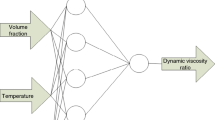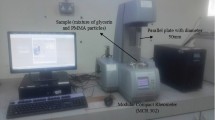Abstract
The presence of wall slip in concentrated suspensions affect the rheological measurements such as shear stress, shear rate, and viscosity. The measured shear rate will have a value lower than the actual shear rate. Therefore, it is important to have a study on such scenario as the concentrated suspensions have a wide industrial application. The current method for actual shear rate prediction is a challenging task and quite time-consuming as several experimental works are required. Therefore, the development of a mathematical model with an acceptable accuracy is required. Multi-layer perceptron neural network (MLP-NN) is employed to develop the prediction model by applying shear stress, volumetric concentration, particle size, and temperature as the input parameters while the actual shear rate is kept as the output variable. MLP-NN model with 9 hidden neurons is the model that has achieved the best performance in term of statistical analyses. Besides, MLP-NN models for five different temperature ranges (i.e., 11–20 °C, 21–30 °C, 31–40 °C, 41–50 °C, and 51–60 °C) are also proposed to investigate the potential of the developed model to achieve a better accuracy and ease the user while dealing with the specified temperature range. It is found that the MLP-NN models with the best performance for each temperature range are the models with 8 hidden neurons, 10 hidden neurons, 8 hidden neurons, 9 hidden neurons, and 9 hidden neurons respectively. The novelty of this research study is the application of artificial intelligence method to mimic rheological actual shear rate under wall slip condition.









Similar content being viewed by others
References
Barnes HA (1995) A review of the slip (wall depletion) of polymer solutions, emulsions and particle suspensions in viscometers: its cause, character and cure. J Nonnewton Fluid Mech 56:221–251
Barnes HA (2000) Measuring the viscosity of large-particle suspensions—a note on the necessary gap size of rotational viscometers. J Nonnewton Fluid Mech 94:213–217
Barnes HA, Hutton JF, Walters K (1989) An introduction to rheology. Elsevier, Amsterdam
Kalyon DM (2005) Apparent slip and viscoplasticity of concentrated suspensions. J Rheol 61:621–640
Kalyon DM, Gokturk P, Aral B (1995) Motion analysis of development of wall slip during die flow of concentrated suspensions. Soc Plast Eng ANTEC Tech Pap 41:1130–1134
Kalyon DM, Gevgilili H (2003) Wall slip and extrudate distortion of three polymer melts. J Rheol 47:683–699
Pérez-González J, López-Durán JJ, Marín-Santibáñez BM, Rodríguez-González F (2012) Rheo-PIV of a yield-stress fluid in a capillary with slip at the wall. Rheol Acta 51:937–946
Yaras P, Kalyon DM, Yilmazer U (1994) Flow instabilities in capillary flow of concentrated suspensions. Rheol Acta 33:48–59
Mooney M (1931) Explicit formula for slip and fluidity. J Rheol 2:210–222
Cohen Y (1982) The behaviour of polymer solutions in non-uniform flows. Ph.D. thesis, University of Delaware, Newark
Cohen Y, Metzner AB (1982) Adsorption effects in the flow of polymer solutions through capillaries. Macromolecules 15:1425–1429
Cohen Y, Metzner AB (1986) An analysis of apparent slip flow of polymer solutions. Rheol Acta 25:28–35
Ahuja A, Singh A (2009) Slip velocity of concentrated suspensions in Couette flow. J Rheol 53:1461–1485
Jana SC, Kapoor B, Acrivos A (1995) Apparent wall slip velocity coefficients in concentrated suspensions of noncolloidal particles. J Rheol 39:1123–1132
Yoshimura A, Prud’homme R (1988) Wall slip corrections for Coutte and parallel disk viscometers. J Rheol 32:53–67
Durairaj R, Mallik S, Seman A, Ekere NN (2009) Investigation of wall-slip effect on lead-free solder paste and isotropic conductive adhesive. Sadhana 35:799–810
Kalyon DM, Yara P, Aral B, Yilmazer U (1993) Rheological behaviour of a concentrated suspension: a solid rocket fuel simulant. J Rheol 37:35–53
Yilmazer U, Kalyon DM (1989) Slip effects in capillary and parallel disk torsional flows of highly filled suspensions. J Rheol 33:1197–1212
Ekere NN, He D, Cai L (2001) The influence of wall slips in the measurement of solder paste viscosity. IEEE Trans Compon Pack Technol 24:468–473
Chin RJ, Lai SH, Shaliza I, Wan Jaafar WZ (2018) Factors affect wall slip: particle size, concentration, and temperature. Appl Rheol 28:15775
Sharma LK, Singh R, Umrao RK, Sharma KM, Singh TN (2017) Evaluating the modulus of elasticity of soil using soft computing system. Eng Comput 33:497–507
Vijayaraghavan V, Shui L, Garg A, Peng X, Singh VP (2018) Crash analysis of lithium-ion batteries using finite element based neural search analytical models. Eng Comput. https://doi.org/10.1007/s00366-018-0587-5
Amiri M, Amnieh HB, Hasanipanah M, Khanli LM (2016) A new combination of artificial neural network and K-nearest neighbours to predict blast-induced ground vibration and air-overpressure. Eng Comput 32:631–644
Gordan B, Armaghani DJ, Hajihassani M, Monjezi M (2016) Prediction of seismic slope stability through combination of particles swarm optimization and neural network. Eng Comput 32:85–97
Koker R, Cakar T, Sari Y (2014) A neural-network committee machine approach to the inverse kinematics problem solution of robotic manipulators. Eng Comput 30:641–649
Taheri K, Hasanipanah M, Golzar SB (2017) A hybrid artificial bee colony algorithm-artificial neural network for forecasting the blast-produced ground vibration. Eng Comput 33:689–700
Azizi S, Awad MM, Ahmadloo E (2016) Prediction of water holdup in vertical and inclined oil-water two-phase flow using artificial neural network. Int J Multiph Flow 80:181–187
El-Shafie A, Noureldin A, Taha M, Hussain A, Mukhlisin M (2012) Dynamic versus static neural network model for rainfall forecasting at Klang River Basin, Malaysia. Hydrol Earth Syst Sci 16:1151–1169
Ruan R, Almaer S, Zhang J (1995) Prediction of dough rheological properties using neural networks. Cereal Chem 72:308–311
Sahoo BK, De S, Meikap BC (2017) Artificial neural network approach for rheological characteristics of coal-water slurry using microwave pre-treatment. Int J Min Sci Technol 27:379–386
Garg A, Li J, Hou J, Berretta C, Garg A (2017) A new computational approach for estimation of wilting point for green infrastructure. Measurement 111:351–358
Garg A, Vijayaraghavan V, Zhang J, Lam JS (2017) Robust model design for evaluation of power characteristics of the cleaner energy system. Renew Energy 112:302–313
Huang Y, Gao L, Yi Z, Tai K, Kalita P, Prapainainar P, Garg A (2018) An application of evolutionary system identification algorithm in modelling of energy production system. Measurement 114:122–131
Shaliza I, Wong SD, Baker IF, Zamzam Z, Sato M, Kato Y (2015) Influence of geometry and slurry properties on fine particles suspension at high loadings in a stirred vessel. Chem Eng Res Des 94:324–336
Buscall R, McGowan J, Morton-Jones AJ (1993) The rheology of concentrated dispersions of weakly attracting colloidal particles with and without wall slip. J Rheol 37:621–641
Akter T, Desai S (2018) Developing a predictive model for nanoimprint lithography using artificial neural networks. Mater Des 160:836–848
Alimissis A, Philippopoulos K, Tzanis CG, Deligiorgi D (2018) Spatial estimation of urban air pollution with the use of artificial neural network models. Atmos Environ 191:205–213
Kai Y, Yaoli Z, Linlin Y, Yingru Z, Ning L, Congkai X (2018) Modeling convective heat transfer of supercritical carbon dioxide using an artificial neural network. Appl Therm Eng. https://doi.org/10.1016/j.applthermaleng.2018.11.031
Zhang Y, Chen H, Yang B, Fu S, Yu J, Wang Z (2018) Prediction of phosphate concentrate grade based on artificial neural network modeling. Results Phys 11:625–628
Alsmadi MK, Omar KB, Noah SA (2009) Back propagation algorithm: the best algorithm among the multi-layer perceptron. Int J Comput Sci Netw Secur 9(4):378–383
Demuth H, Beale M (2004) Neural network toolbox for use with MATLAB user’s guide version 4. The MathWorks Inc., Natick
Pham D, Sagiroglu S (2001) Training multilayered perceptrons for pattern recognition: a comparative study of four training algorithms. Int J Mach Tools Manuf 41:419–430
Acknowledgements
The authors would like to express the highest gratitude for financial support from FRGS Grant no. FP015-2014A awarded by Ministry of Higher Education (MOHE) Malaysia. The authors would like to thank Faculty of Engineering University of Malaya for the facilities provided for the experimental works. The authors also would like to thank Dr. Ashok Kumar for his contribution.
Author information
Authors and Affiliations
Corresponding author
Additional information
Publisher’s Note
Springer Nature remains neutral with regard to jurisdictional claims in published maps and institutional affiliations.
Rights and permissions
About this article
Cite this article
Chin, R.J., Lai, S.H., Ibrahim, S. et al. New approach to mimic rheological actual shear rate under wall slip condition. Engineering with Computers 35, 1409–1418 (2019). https://doi.org/10.1007/s00366-018-0670-y
Received:
Accepted:
Published:
Issue Date:
DOI: https://doi.org/10.1007/s00366-018-0670-y




